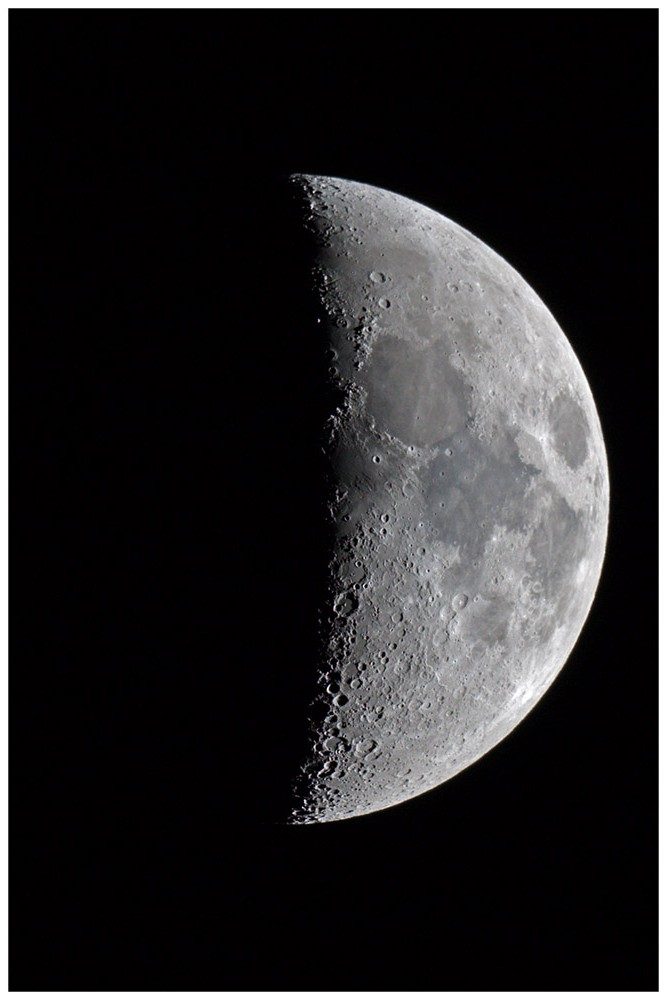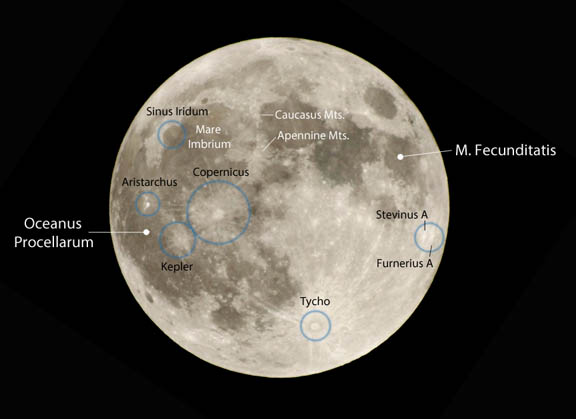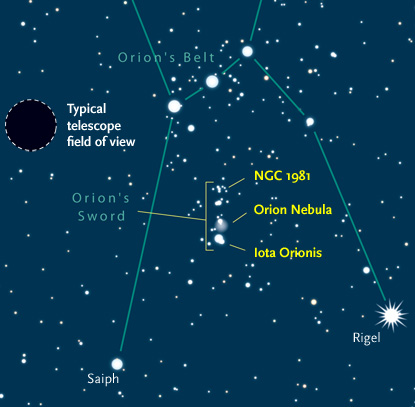Astronomy - What to See with Your New Telescope

The waxing Moon just before first-quarter phase, as it appears in an amateur telescope magnified about 40 times. The Moon changes phase from night to night, revealing new features every step of the way. The Moon will next be at this particular phase, with the terminator running almost down the middle, on the evening of January 4, 2017.
Maybe this gift-giving season you got a shiny new telescope to call your own. Congratulations — you could be on your way to discovering many amazing far things in the night sky. Although most of them are so far and faint that just finding and detecting them is the challenge! Whether your new scope is a long, sleek tube or a compact marvel of computerized wizardry, surely you're itching to try it out.
"Here are three important tips for getting started," advises Alan MacRobert, a senior editor at Sky & Telescope magazine.
"First, get your scope all set up indoors, read the instructions, and get to know how it works — how it moves, how to change eyepieces, and so on — in warmth and comfort. So you don't have to figure out unfamiliar knobs, settings, and adjustments outside in the cold dark.
"Second, take it outside in the daytime and get familiar with how it works on distant scenes — treetops, buildings — to get a good sense of what it actually does. For instance, you'll find that a telescope's lowest magnification gives the brightest, sharpest, and widest views, with the least amount of the wiggles. The lowest power also makes it easiest to find what you're trying to aim at. So, you'll always want to start off with the lowest power. Switch to a higher power only after you've found your target, got it centered, and had a good first look.
"Also, if the telescope has a little finderscope on the side, daytime is the easiest time to 'align' the finderscope. Point the main telescope at a distant treetop or landmark, center it in the view, and then look through the finderscope. Use the finderscope's adjustment screws to get the crosshairs centered on the same treetop.
"Third," he adds, "be patient. Spend time with each sky object you're able to find, and really get to know it." Too many first-time telescope users expect Hubble-like brightness and color in the eyepiece — when in fact most astronomical objects are very dim to the human eye. And our night vision sees almost everything as shades of gray. Much of what the universe has to offer is subtle, and, once again, extremely far away. But the longer and more carefully you look, the more will come out.
On the other hand, the Moon and planets are bright and easy to find! They make excellent first targets for new telescopic observers. Sky & Telescope's This Week's Sky at a Glance has suggestions for both telescopic and naked-eye viewing of the brightest stars and planets.
Here are some suggestions for starting off:
New-Telescope Delight: The Moon
The Moon is one celestial object that never fails to impress in even the most humble scope. It’s our nearest neighbor in space — big, bright, starkly bleak, and just a quarter million miles away. An amateur telescope and a good Moon map can keep you busy forever.

See if you can identify these noteworthy features in your scope around the time of full Moon. Some of the most prominent craters display bright rays: splashes of impact debris.
Bob King
Bob King
The crescent Moon will start returning to the evening sky around January 1st; look for it southwest in twilight. Each evening for nearly week after that the Moon will thicken and shine higher. It waxes all the way to full on the night of January 11th. But in some respects, the full Moon is actually the worst time for telescopic Moon viewing, because its full sunlit face lacks shadows to cast mountains and craters into sharp relief. The waxing and waning phases are better, especially for features along the terminator — the lunar sunrise or sunset line — when hills, mountains and craters cast long shadows and stand out in stark relief. The terminator moves quite a bit from night to night, revealing new lunar landscapes.
Evening Planets
You can't miss the brilliant "Evening Star" Venus in the southwest these evenings during and after dusk. Venus is by far the brightest planet. Its permanent white clouds forever hide its surface, but watch Venus go through Moon-like phases as it swings around the Sun from our viewpoint. Right now in a telescope, Venus is a smallish (but dazzling) gibbous ball. Venus will enlarge in the coming months as it swings toward us, while waning in phase to become half-lit and finally, in March, a larger, ever thinner eerie crescent.
Mars glows orange to Venus's upper left all winter, but don't expect much. Mars is a small planet to begin with, and this season it's on the far side of its orbit from us, making it just a very tiny blob in any telescope.
Dawn Adventure: Jupiter
The solar system's largest planet awaits night owls and early risers. The best time for Jupiter now is before the first light of dawn, which means about 1½ to 2 hours before your local sunrise time. Make an adventure of it!
Around that time, Jupiter is by far the brightest point on the southern side of the sky. "Jupiter is the king of the planets and the most interesting one for a small telescope," says MacRobert. "It's big, it's bright, it has cloud belts, and it has four moons that do interesting things."
Even at 50× or 100×, you should be able to make out two dusky-tan bands girding Jupiter's midsection: the North and South Equatorial Belts. These, and the bright Equatorial Zone between them and Jupiter's lesser belts and zones, are cloud features akin to jet streams high in the Jovian atmosphere. (Jupiter is a gas giant with no solid surface.)
Larger telescopes — those whose main mirror or lens is at least 6 inches across — might bring a few more belts and zones into view, along with an assortment of spots and streaks. The famous Great Red Spot, a huge cyclonic storm larger than Earth, is more strongly colored now than it has been in recent decades, so you may detect it even in a small scope if you're looking at a time when it's facing Earth. Jupiter completes a rotation in just under 10 hours — causing its globe to bulge out visibly at the equator — and the Red Spot is easiest to see around when it crosses the midline of Jupiter's Earthward face. You can find the times when this happens using our online app.
With your first look at Jupiter, you'll immediately notice the array of bright moons on either side of it, roughly aligned with the belts. These are the four "Galilean satellites," named for Galileo, who discovered them from Italy in 1610. "From night to night you'll see their movement as they shuttle around Jupiter," notes MacRobert. "Sometimes not all four are visible: occasionally one of them ducks behind Jupiter or is hidden in its shadow." Their own tiny black shadows sometimes cross Jupiter's face. How can you tell which moon is which? We've got an app for that too.
For more about what to look for on and around Jupiter, check out our Jupiter observing guide.
Other New-Telescope Sights
There's more to the night sky than the nearby Moon and planets, of course. Winter evenings often bring crisp, transparent skies with a grand canopy of stars. But with so many inviting targets overhead, where should you point first?

This chart shows where to find the Orion Nebula, in Orion's Sword below the trio of stars forming Orion's Belt. Only the brightest stars (the largest dots) on this chart are readily visible to the unaided eye.
The familiar constellation Orion climbs in the southeast after dark. In its middle, look for the three-star line of Orion's Belt. It's currently nearly vertical in early evening, and it's diagonal (like on the chart at right) late at night.
Just a few degrees south of the Belt runs a smaller, dimmer line: Orion's Sword. Within it lies the Orion Nebula, a luminous cloud of gas and dust where stars are forming by the hundreds. It shows pink in photographs, but dim gray with a hint of green to the human eye. The nebula is plain in any telescope once you get pointed at it, and so is the tight quartet of stars near its center, called the Trapezium. Astronomers sometimes refer to this nebula as Messier 42 (M42), and you might see it labeled that way on star charts. Located about 1,400 light-years away, it's the closest massive star-forming nebula to Earth.
You can use Orion's Belt as a pointer to other things. Extend the line far upward, past the relatively bright star Aldebaran (the orange-red eye of Taurus, the Bull) and you'll reach a little cluster of stars called the Pleiades. It's about the size of your fingertip held at arm's length.
Through binoculars or a telescope at its lowest magnification, the Pleiades cluster shows dozens of stars. Astronomers have found that the cluster has about 500 in all. Like other star clusters, the Pleiades are bound together by their mutual gravity. Collectively called an open cluster for their relatively uncrowded arrangement, the Pleiades move together through space as a swarm. They're about 440 light-years away.
Researchers have determined that the Pleiades began to shine roughly 70 to 100 million years ago. This makes the stars mere toddlers compared to our Sun and solar system, age 4.6 billion years. M45’s youthful suns are astonishingly energetic. Alcyone (al-SIGH-oh-nee), the brightest, is at least 350 times as luminous as our Sun. Like the other Pleiads it gleams with an intense blue-white light — a sign that it’s unusually hot and massive.
Next Steps in Astronomy
To find much else in the night sky, you'll need to start learning the bright naked-eye constellations. They're the key to locating everything fainter and deeper to hunt with binoculars or a telescope — the same way you'd need to know the continents and countries on a globe of Earth before you could pinpoint Thimphu, Bhutan, in south Asia. For an easy-to-use constellation guide covering the whole evening sky, use the big monthly map in the center of each issue of Sky & Telescope magazine, the essential guide to astronomy (ahem).
You'll also want a good, detailed star atlas (set of maps), such as the widely used Pocket Sky Atlas; a good deep-sky guidebook; and some practice in how to use the maps to pinpoint the aim of your telescope on something. (There are a few key tricks to this — see Using a Map at the Telescope.)
For more tips on skywatching and how to get the most out of your telescope, see our Observing section and Getting Started section.
Whatever else, stick with it! Nobody is born knowing this stuff. Everyone has to work their way into the hobby at their own comfortable pace, finding things to know and do and understand and not worrying about everything they don't yet. Living in the universe is like that.
No comments:
Post a Comment